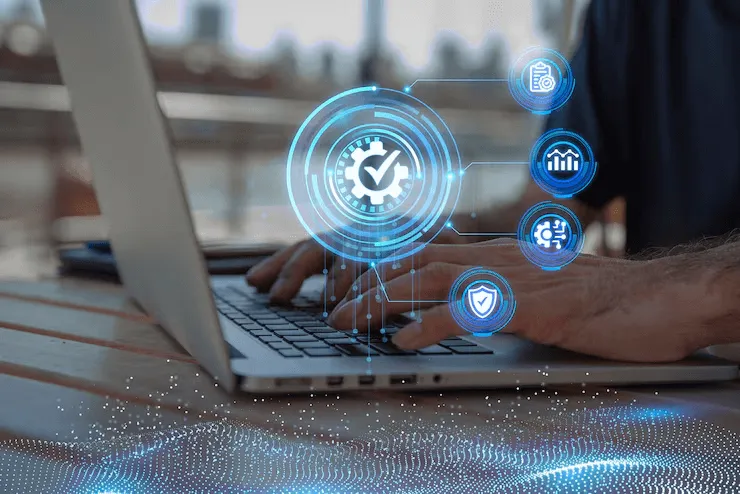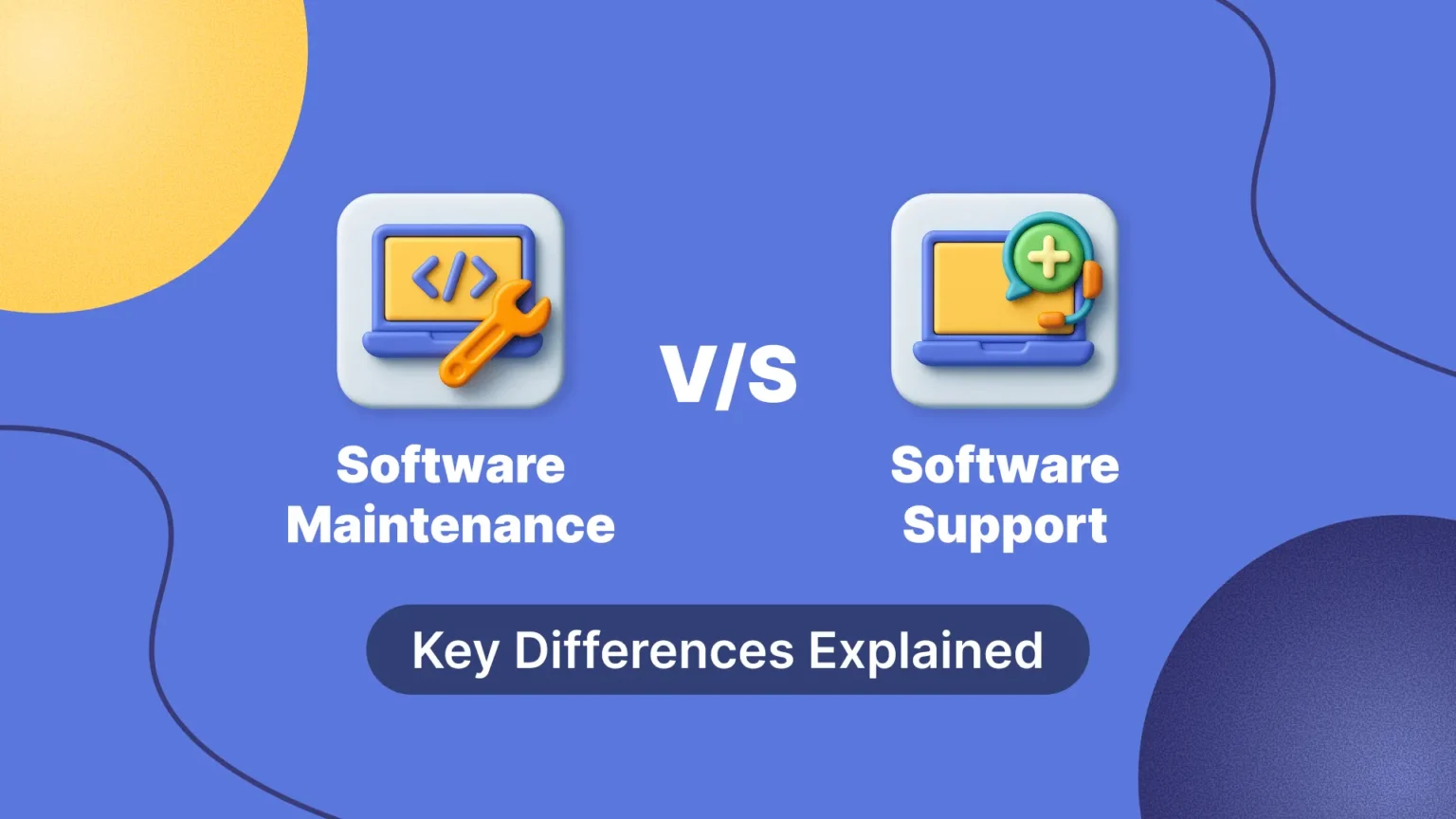Imagine this: A fast-emerging e-commerce startup rolls out a brand-new mobile app. A few weeks later down the line, there are technical glitches, users are disappearing at a pace and the entire team is in a panic mode. They make contact with one of the vendors give them a request and are apprised that they need maintenance, not support. Confused? They are not isolated.
When people are speaking quickly about the hectic digital world, they are likely to share such words as software maintenance and software support and they are not interchangeable. Such confusion may result in miscast expectations, cost overrun, or even reduced time. A report by IEEE shows that more than 60 percent of the costs in the software lifecycle are not on development, but rather on maintenance. However, a lot of companies do not comprehend what it implies.
In a market where application performance directly affects customer retention and even a one-second delay in mobile loading can reduce conversions by 20% recognizing the need for maintenance or support can be the deciding factor between success and failure.
What is Software Maintenance?
Software maintenance ensures that your application continues to perform optimally even after launch. Think of it like routine health check-ups or regular tune-ups for your car it keeps everything running smoothly. Just like your app or website, it needs to function reliably, stay secure, and evolve alongside the ever-changing technology landscape.
When Software Maintenance vs Software Support is discussed, the tools of software upgrading are aimed at the advancements and continuous developments of the programs, whereas the support normally includes some emergency repairs and user-support requests.
Every business should understand the four main types of software maintenance:
- Corrective Maintenance: Solves bugs or any kind of errors that occur when the software is alive. An example is a crash that a particular app would have because of a bug.
- Adaptive Maintenance: Ensures that your software behaves well with specially upgraded hardware, operating system, or third-party tools. One of them can be the effort to update your mobile application in case of a new OS version released by Apple or Android.
- Perfective Maintenance: Involves refining and enhancing existing features to improve performance and optimize the user experience. It may be having your site resolutely quicker to download, or it may relate to your adding a fresh easy-to-use feature due to customer responses.
- Preventive Maintenance: This makes your software ready for the future by detecting upcoming issues and repairing them before they create problems. Think of it as routine maintenance to extend the lifespan of your software.
A good example would be? Think of your app being dependent on Google Maps. In case Google makes any updates to its API, then such updates make it necessary to have adaptive maintenance to maintain it in optimal operation.
Software maintenance is one of the most important concepts to know when it comes to Software Maintenance vs Software Support– it enables you to have a better understanding of what to expect, get your accountability balanced, and prevent some surprises that may destabilize your users.
What is Software Support?
Software support is the kind of service that assists people in overcoming problems and being satisfied with their software. Whereas software maintenance is all about ensuring that the system is technically up to date, software support is about real-time assistance in case of a problem or when the user is in need. The knowledge of this difference in the Software Maintenance vs Software Support dialogue will help your business save you time and frustration.
Quite simply, software support is similar to having someone on hand who will assist either you or your client when things fall apart or when you need information as to how the item can be made use of.
Reliable software support services for businesses typically fall into three main categories:
- Technical Support: It is the helpdesk or the ticket system which troubleshoots technical issues. As an example, when your employees are not able to access a feature or face an unforeseen error, the technical support team works on it and corrects it.
- Operational Support: This will make the software run effectively when used daily. One of them is related to system performance observation, configuration management, and backup management. In the case of cloud-based applications, support of its operation so that everything would run 24 hours a day.
- User-Level Support: This will include the support of user training and instructions. It has frequently asked questions, training tutorials on how to use the system, video tutorials on how to do this or that, and direct support of frequent activities. As an example, assist a new customer to understand how to create his/her profile or to reset his/her password.
- Considerable analogy: Simply think of a user who just cannot log in to your app. Although the maintenance of software would eliminate bugs that encounter failures during the log-in procedure, the software support plays an active role in assisting the user in resetting their data and being able to go online within a short duration of time.
Support is important in customer satisfaction besides creating trust, which is a crucial element in the decision of which type of service to fill your company with Software Maintenance vs Software Support.
Also Read: Why is Software Testing Important?
Side-by-Side Comparison: Software Maintenance vs Software Support
In order to comprehend Software Maintenance vs Software Support there is no better way to compare them one with another. Most businesses believe they only require one of them, however, both are essential to ensuring that your software is stable and that your consumer base is satisfied. Here is a description of how they are different and why it is possible that your business may require both.
To outline some of the most important differences, one should use a clear comparison table:
| Aspect | Software Maintenance | Software Support |
| Purpose | Improve, update, and future-proof software to ensure long-term performance and compatibility. | Help users resolve issues, answer questions, and provide immediate assistance with software usage. |
| Who Performs It | Software developers, QA engineers, and maintenance teams. | Customer support agents, technical help desk staff, and product specialists. |
| Timeline | Planned and ongoing, based on a maintenance schedule and software lifecycle. | On-demand and continuous, depending on user needs and issue frequency. |
| Cost Structure | Usually part of a fixed annual maintenance contract or retainer. | Typically charged per support ticket, per user, or bundled into a subscription plan. |
| Scope of Work | Includes bug fixes, performance improvements, security patches, and updates for new hardware or OS versions. | Covers troubleshooting, password resets, user training, onboarding help, FAQs, and basic troubleshooting. |
| Example Scenarios | Updating an app to support a new Android version, fixing hidden bugs before they affect users. | Assisting a user who can’t log in, guiding customers through setting up a new feature. |
In a comparison between software maintenance and software support, it is obvious that one complements the other. Maintenance avoids issues before they even occur– such as, so your software does not break when a third-party API is updated. Support intervenes at the moment when a real user is faced with an obstacle-such as I have a question on using this new dashboard.
Enterprises that make such investments have better user satisfaction, reduced downtime, and unexpected expenses. A survey released a few years ago showed that businesses whose software maintenance is proactive and whose software support is responsive enjoy a retention rate of 30 percent compared to 25 percent retention of businesses whose software maintenance is reactive and active.
To make it short, software maintenance is keeping your system fit and healthy behind the scenes, whereas software support is making your users pleased at the first line. Collectively, they can allow your software to provide consistent value, increase trust, and enhance the positive reputation of a brand in the competitive marketplace.
How Software Maintenance and Support Work Together

Many organizations argue against Software Maintenance and Software Support, but the fact is that it is never a matter of either or. To make any contemporary software or app a success in the long run, the two must be in perfect collaboration like how regular car maintenance and breakdown services keep your automobiles on the road.
Consider software maintenance as your regular checkup of your car. It maintains a clean engine, fresh oil, and updated parts to ensure you can drive without the fear of noticing an accident at some point. Periodic checks prolong the life of your car and help you avoid expensive repairs in the future.
Alternatively, the software support is similar to the one that provides you with 24-hour road assistance. Despite all possible maintenance, you may still face an emergency, such as a flat tire, a dead battery, or a lock-out. When this occurs, then rapid, trustworthy assistance is required to put you back on the road without significant setbacks.
This analogy has led to the fact that Software Maintenance and Support would ideally be packaged together on one service contract. By paying a reliable software vendor to take care of the two, you achieve:
- Proactive Care: Your software can be maintained by the maintenance teams to be secure, compatible, and up-to-date, thus reducing risks before they affect the users.
- Real-time help: Support teams can find solutions to the problem such as questioning or guiding users in the new features, especially when it is a source of instant satisfaction and loyalty.
Companies that engage in mixed software maintenance and support undergo reduced technical emergencies, smooth running of software, and contented users. Another study revealed that the downtime of an organization that is more integrated with a support and maintenance plan gets minimized by 40 percent and unexpected expenditures are lessened by close to 30 percent.
Communication is made easier with the bundling of the two services. You can work with a single vendor as opposed to working with several vendors who do not understand your software fully. This is cost-effective, accountable, and faster in the solving of problems.
During Software Maintenance vs Software Support, the best thing to do is not to choose the side of annihilation but invest in both of them as an all-in-one piece of care software. This will keep your product ahead of the game your customers contented, and your company relevant in the dynamic and ever-changing technological world.
When Should You Choose Maintenance vs Support?
Understanding when to invest in Software Maintenance and Support can save you time, reduce costs, and prevent unnecessary headaches. Although they are both significant, your immediate needs will, in most cases, define which one should get more attention.
The following is an easy rule of thumb:
- Select Software Maintenance should you have a stable system and only require updates.
Possibly your app is perfectly functioning but the technology it is designed on is becoming obsolete. Or there are new security threats that demand continuous patching. Or you need to increase speed, and efficiency, or match the new devices. At such a time, proactive maintenance would ensure your software is healthy and competitive up to the time when something might go wrong and affect your users.
- Select Software Support when you are continuously called out to troubleshoot by your users or when they require to be held by hand.
Do you have a lot of customers constantly inquiring as to how to use some feature? Do we have a lot of requests to reset passwords or misunderstandings in onboarding? Such support is very strong and one feels that there is always an individual who would sort out issues promptly and enlighten users to ensure their satisfaction. It is particularly important to companies whose customers are non-technical people who demand fast response.
To simplify this, consider the following easy decision flow:
Are there more bugs and technical debts inside? → Pay attention to maintenance.
Are a majority of the problems user questions and requests for help? → Support focus.
Do you need them both? -> Bundle Maintenance and Support to be completely at peace.
A case study: Let us say you are running a fintech app with sensitive information; you do not want outdated code to affect its performance; software maintenance becomes lawful to ensure your safety via compliance. Simultaneously, the rapid support of the software is important in case your app has an increasing number of users since you will not lose them due to their questions, which are easily answered, and the issues with accounts, which can be fixed right away.
A smart business understands that it is not always one or the other when making comparisons between Software Maintenance and Software Support. It concerns the process of evaluating your existing pain points and adjusting services to that scale.
Learning when to prioritize any of them helps you plan, smartly spend your budget, and provide your users with an experience they can trust, which keeps your company on top of the ever-competitive business environment.
Cost Differences: Support vs Maintenance
In contrast to Software Maintenance against Software Support, one of the largest considerations in a business is the cost. The knowledge of pricing can assist you in creating a budget carefully and without sudden outgoes.
Software Maintenance is normally provided as a retainer facility. This is where you pay a monthly or annual fixed fee that will keep it updated, add security patches, and also improve your performance. This predictable expenditure includes proactive efforts that make your application stable and future-proof.
Software Support, on the contrary, is usually pay-per-use or part of a subscription. You may either pay per support ticket, per user, or select a helpdesk plan according to anticipated request volume.
The amounts of money that you will pay for both services depend on several factors:
- Complexity of App: The more complicated the system, the more specialized the developers or support agents should be.
- Service Level Agreement (SLA): The complicated response time and 24/7 service is usually more expensive.
- Number of Users: The more the number of users, the more tickets and the more updates, and it will cost a lot in both the cases in maintenance and the supply of support.
Pro Tips for Choosing a Vendor:
- Seek out care providers that have easy-to-read prices and referrals.
- Make sure that they provide bundled Software Maintenance and Support; sometimes this is rather affordable as compared to using independent vendors.
- The reliability can be calculated by asking about actual case studies and client references.
To sum up, there might be various offers of Software Maintenance vs Software Support, so money is well spent when maintaining both. As a result, this will make your software safe and satisfy users, and avoid excessive emergency expenses in the future.
Best Practices for Managing Post-Launch Software Services

Post-launch software maintenance and support are essential to make sure that your application is not less reliable and that your users are content with the provided software. The moment you have gone live with your product is when the actual effort starts– reactionary support, preemptive care for your product, and success, in the long run, can be guaranteed by your proactivity.
These are some of the best practices:
Report Bugs and Reviews in a Correct Way:
Maintain a log of bug reports, feature requests, and user complaints. An accurate record assists your maintenance team to focus on the repair work and your support team to fix the problem in less time. Future updates and improvements are also informed by well-documented feedback.
Work out Clear SLAs and Communicate:
Introduce realistic Service Level Agreements (SLAs) on maintenance as well as support. This draws up expectations on speed of response and response. Ensure that clients and the internal teams understand definitely whom (and how) to contact should it be a dedicated helpdesk, email, or live chat.
Automated Alerts: Make use of the Monitoring Tools:
Invest in real-time monitoring tools that monitor the uptimes, performance, and security. Regular alerts are automatically sent to your group and hint at possible problems before they affect users. This takes away the difference between software maintenance and software support because it averts issues and offers quick responses when they arise.
Establish a Standing to Reoccurring Audit Performance Metrics:
The frequency of bugs, support tickets, and system performance are some of the most important measures that should be examined in the framework of regular audits. This knowledge will assist you in perfecting your after-launch strategy, managing budgets in a reasonable way, and calculating the ROI of your services in maintenance and support.
To conclude, intelligent post-launch works to integrate transparent operations, automation, and communication. By following these best practices, you can maximize the value of your software maintenance and support, minimize unexpected issues like unplanned downtimes, and cultivate a loyal user base that trusts your software for the long haul.
Also Read: Suggested First Step for Entering Software Development
Conclusion
Learning the difference between Software Maintenance and Software Support is important because it is the only way to keep your app or website healthy and your users happy. Maintenance aims at saving structure before the problem arises by providing updates, whereas support will provide immediate assistance to the users in case they encounter problems.
A combination of both in an intelligent balance favors most of the growing businesses. The best time to evaluate your current system is now, does the current system require more proactive updates, more user assistance, or both?
Do you need an old reliable mobile app development company to manage the performance of your app, or just a reliable web development company to take on the maintenance features, whatever it is that you need, we have you covered.
Do not hesitate and contact us now to get a personalized software maintenance and support strategy designed according to your company objectives. Why not keep your software users’ content and your software ready to go through the passage of time?






